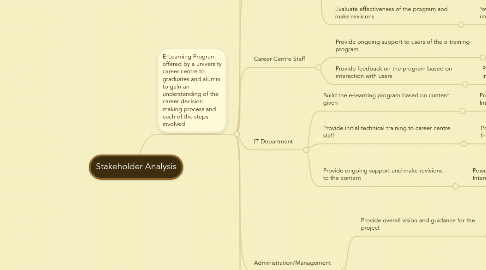
1. E-Learning Program offered by a university career centre to graduates and alumni to gain an understanding of the career decision making process and each of the steps involved
1.1. Graduates & Alumni
1.1.1. Advocate and demonstrate the need for accessible programming
1.1.1.1. Power: High Interest: High
1.1.1.1.1. Need for career education
1.1.2. Use training to understand the steps of career decision making process and put learning into practice
1.1.2.1. Power: Low Interest: High
1.1.2.1.1. Desire to gain new knowledge and self-improve
1.1.2.1.2. Need for career information
1.1.2.1.3. Comfort level with technology and online learning environment
1.1.3. Provide feedback to improve future content development and user experience
1.1.3.1. Power: High Interest: Low to Medium
1.1.3.1.1. Desire to contribute and improve future program
1.2. Career Counsellors
1.2.1. Provide content for the courses
1.2.1.1. Power: High Interest: High
1.2.1.1.1. Equipped with knowledge and expertise
1.2.2. Provide insights on learners' needs and styles
1.2.2.1. Power: High Interest: High
1.2.2.1.1. Experienced in working with students, recent graduates and alumni
1.2.3. Liaise with other interested parties such as employers to collect information for content development
1.2.3.1. Power: Low Interest: High
1.2.3.1.1. Existing relationships with interested parties
1.2.4. Evaluate effectiveness of the program and make revisions
1.2.4.1. Power: High Interest: Low to Medium
1.2.4.1.1. Desire to ensure a successful program
1.2.4.1.2. Accountable for the success of the program
1.3. Career Centre Staff
1.3.1. Provide ongoing support to users of the e-training program
1.3.1.1. Power: Low Interest: Low
1.3.1.1.1. Comfort level with technology and ability to help users troubleshoot
1.3.2. Provide feedback on the program based on interaction with users
1.3.2.1. Power: High Interest: Low to Medium
1.3.2.1.1. Desire to contribute to the project and improve effectiveness of the program
1.4. IT Department
1.4.1. Build the e-learning program based on content given
1.4.1.1. Power: High Interest: Medium
1.4.1.1.1. IT capacity and expertise to execute
1.4.2. Provide initial technical training to career centre staff
1.4.2.1. Power: High Interest: Low to Medium
1.4.2.1.1. Existing knowlege
1.4.2.1.2. Willingness to disperse knowledge
1.4.3. Provide ongoing support and make revisions to the content
1.4.3.1. Power: High Interest: Low
1.4.3.1.1. Desire to create a successful product
1.4.3.1.2. Accountable for creating a successful product and ensure continued success
1.5. Administration/Management
1.5.1. Provide overall vision and guidance for the project
1.5.1.1. Power: High Interest: High
1.5.1.1.1. Create business case for project and communicate vision
1.5.1.1.2. Communicate vision and create business case for project
1.5.2. Provide funding to develop the e-learning program
1.5.2.1. Power: High Interest: Medium
1.5.2.1.1. Available funding
1.5.2.1.2. Need and desire to implement program
1.5.2.1.3. Available funding
1.5.2.1.4. Need and desire to implement program
1.6. Parents/Community Groups
1.6.1. Promote the value of career education
1.6.1.1. Power: Low Interest: High
1.6.1.1.1. Desire and invested in students' career development
1.7. Employers
1.7.1. Contribute industry expertise and market trends to the content of the courses
1.7.1.1. Power: Medium Interest: Medium
1.7.1.1.1. Willingness to contribute expertise and knowledge
1.7.1.1.2. Desire to participate in the project
